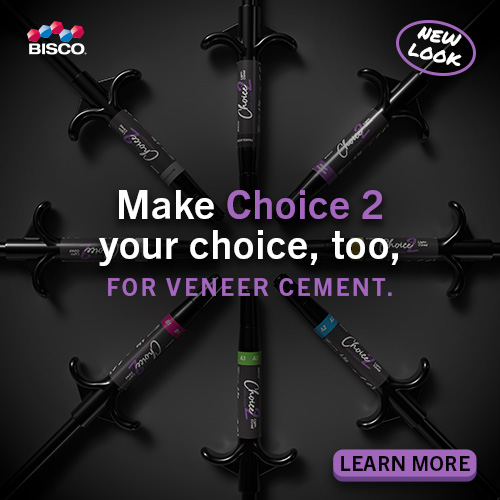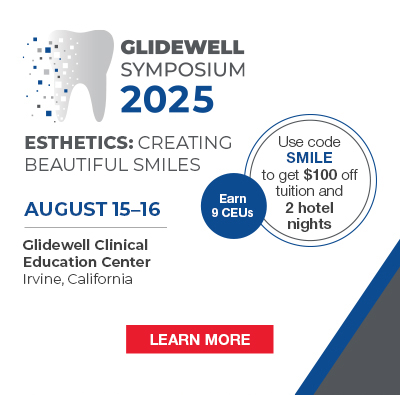In First Impressions George Freedman, DDS, gives readers a brief summary of products that have recently been introduced to dentistry, based on his clinical experience.
|
XP BOND |
||||
As adhesives have become indispensable in dentistry, the dilemma of which bonding agent to use, where, when, and why, has developed. DENTSPLY Caulk has introduced XP BOND, a universal total-etch adhesive that uses a tertiary-butenol solvent with PENTA and nanotechnology chemistry. The unique combination of adhesion promoter resins (PENTA, TCB, TEGDMA, and UDMA) provides excellent polymerization cross-linkage for high bond strength to both dentin and enamel. It has excellent stability during the adhesion process and seals tubules with deep penetration into moist collagen even when the dentin is over-dried. The addition of HEMA allows increased filler content, reduces volatility, and increases collagen penetration. The adhesive nanofiller particles are far smaller than previous bonding fillers, delivering a more densely packed bonding matrix and offering improved marginal integrity, increased adhesion strength, and a low film thickness in a one-coat, one-cure technique. XP BOND is less volatile, with up to 15 minutes of working time. The adhesive layer does not require separate light-curing with indirect restorations; mix the XP BOND adhesive with the self-cure activator and use directly with either the dual- or self-cure resin cement. The XP Bond cementation technique is simple. Etch enamel 15 seconds, then etch dentin 15 seconds. Remove acid gel, rinse 15 seconds, and remove excess moisture. Dispense equal amounts XP Bond and self-cure activator into CliXdish Mix. Apply it to all cavity surfaces (avoid pooling). Leave adhesive undisturbed for 20 seconds. Evaporate the excess. Dispense self- or dual-cure resin cement into silanated restoration and place. Spot-cure, remove marginal excess, and light-cure margins.For more information, call (800) 532-2855 or visit caulk.com. |
|
Artiste Nano-Hybrid Flowable Base Liner |
  As we examine the radiograph of the restored tooth, we notice the area of redecay that has developed along the interface of the composite restoration with the enamel and the dentin. Obviously, it is time to redo the restoration. Or is it? Is this truly re-decay, or is it just the radiolucent nature of the flowable base (or liner) that was placed underneath the composite restoration? Easy enough to check in the chart if we were the ones who did the restoration originally, but far more difficult diagnostically if it is somebody else’s dental work. Would it not be far simpler, and more predictable, if all practitioners used a flowable base or liner underneath their restorations that was radiopaque? Pentron Clinical Technologies has recently introduced its Artiste Nano-Hybrid Flowable Base Liner for use as a base (or a liner) underneath composite restorations. Its radiopacity is 400% that of aluminum; therefore, there is absolutely no chance of mistaking it for a radiolucent area or misdiagnosing it as recurrent decay. It has been engineered to flow easily onto the prepared tooth surfaces and offers excellent handling properties. The nanohybrid formula provides an effective consistency when used as a liner and very good infrastructural strength. The inclusion of fluoride in the flowable chemistry minimizes caries recurrence, particularly the exposed margins and at the enamel and dentin interfaces. For cases where the discolored dentin requires masking, the universal opaque shade provides an effective aesthetic adjunct. Used as a liner or base, Artiste Nano-Hybrid Flowable Base Liner not only provides a solid, dependable foundation for a restoration, but also eliminates future diagnostic uncertainty or misdiagnosis.For more information, call (800) 551-0283 or visit pentron.com. As we examine the radiograph of the restored tooth, we notice the area of redecay that has developed along the interface of the composite restoration with the enamel and the dentin. Obviously, it is time to redo the restoration. Or is it? Is this truly re-decay, or is it just the radiolucent nature of the flowable base (or liner) that was placed underneath the composite restoration? Easy enough to check in the chart if we were the ones who did the restoration originally, but far more difficult diagnostically if it is somebody else’s dental work. Would it not be far simpler, and more predictable, if all practitioners used a flowable base or liner underneath their restorations that was radiopaque? Pentron Clinical Technologies has recently introduced its Artiste Nano-Hybrid Flowable Base Liner for use as a base (or a liner) underneath composite restorations. Its radiopacity is 400% that of aluminum; therefore, there is absolutely no chance of mistaking it for a radiolucent area or misdiagnosing it as recurrent decay. It has been engineered to flow easily onto the prepared tooth surfaces and offers excellent handling properties. The nanohybrid formula provides an effective consistency when used as a liner and very good infrastructural strength. The inclusion of fluoride in the flowable chemistry minimizes caries recurrence, particularly the exposed margins and at the enamel and dentin interfaces. For cases where the discolored dentin requires masking, the universal opaque shade provides an effective aesthetic adjunct. Used as a liner or base, Artiste Nano-Hybrid Flowable Base Liner not only provides a solid, dependable foundation for a restoration, but also eliminates future diagnostic uncertainty or misdiagnosis.For more information, call (800) 551-0283 or visit pentron.com. |
|
Crown Prepping Carbides |
||||
A number of major clinical considerations face the dental practitioner during the crown preparation process. Some of these are the speed of in-mouth preparation, the relative patient comfort during preparation, the predictability of the abutment shape, and the overall clinical control of the preparation. In fact, the effective positional control of the bur on the tooth during preparation (considering that it is rotating at 300,000 revolutions per minute) should be the primary concern of every practitioner. A bur that “grabs” the tooth structure or leads the practitioner’s hands may prepare too far, too fast, or too deeply to deliver the desired crown preparation. A bur that cuts too slowly and requires excessive torque is likely to fatigue both the dentist and the patient and is likely to slow down the preparation process, making for a rather tired and uncomfortable patient. KOMET USA’s Crown Prepping Carbides are designed to eliminate most of the bumps and jumps that are commonly felt and seen with carbide instruments. These reduce chatter by a specific pattern design, offering one of the fastest, smoothest, most chatter-free tooth preparation options. The bur design, in turn, allows for precise and controlled tooth reduction for virtually any preparation. The KOMET carbide pattern encourages the dentist to accomplish both the gross and the fine preparation with the same bur (and at the same time). Even the finishing of the preparation can be accomplished concurrently using the same burs. The finished surface is comparable to that achieved with using diamond finishers. The Crown Prepping Carbides save time, effort, and money.For more information, call (888) KOMET-USA (566-3882) or visit komet-usa.com. |
|
LuxaBond Total Etch |
  As practicing dentists, most of us are aware that not all bonding agents work equally well with all resin-based cements. Cements and composites are most often classified into light-cure, self-cure, and dual-cure categories. Bonding agents are typically sorted into these categories as well. Generally, light-only activated adhesives have no chemical interaction with self-cure and most dual-cure composites. Occasionally, effective additional dual-cure activators can bridge this chemical gap, but how and when to use them can be rather mystifying. The clinical di-lemma that many practitioners face is to determine which cements and bonding systems are actually compatible. LuxaBond Total Etch from Zenith Dental/DMG has been specifically formulated for indirect techniques. This dual-cure adhesive system is compatible with all dual-cure and all self-cure resin materials. Since it requires no light initiation for polymerization to begin, it is specifically indicated for indirect techniques such as core buildups and the cementation of inlays, on-lays, crowns, and bridges. The LuxaBond Total Etch system consists of prebond and adhesive components that develop excellent ad-hesion. Specifically de-signed endo brushes facilitate the application of the adhesive inside canals (post cementation), offering a predictable wetting of the entire surface every single time. Its dual-cure bonding system ensures that the adhesive inside the canal does not pool and polymerize prematurely, thereby altering post placement accessibility and core positioning. It also contains no acetone. This im-provement in chemistry increases its shelf life and decreases its chairside technique sensitivity—minimal time constraint during clinical application diminishes dentist stress during post cementation. LuxaBond Total Etch is the perfect 3-bottle partner for indirect adhesive techniques.For more information, call (800) 662-6383 or visit the Web site zenithdental.com. As practicing dentists, most of us are aware that not all bonding agents work equally well with all resin-based cements. Cements and composites are most often classified into light-cure, self-cure, and dual-cure categories. Bonding agents are typically sorted into these categories as well. Generally, light-only activated adhesives have no chemical interaction with self-cure and most dual-cure composites. Occasionally, effective additional dual-cure activators can bridge this chemical gap, but how and when to use them can be rather mystifying. The clinical di-lemma that many practitioners face is to determine which cements and bonding systems are actually compatible. LuxaBond Total Etch from Zenith Dental/DMG has been specifically formulated for indirect techniques. This dual-cure adhesive system is compatible with all dual-cure and all self-cure resin materials. Since it requires no light initiation for polymerization to begin, it is specifically indicated for indirect techniques such as core buildups and the cementation of inlays, on-lays, crowns, and bridges. The LuxaBond Total Etch system consists of prebond and adhesive components that develop excellent ad-hesion. Specifically de-signed endo brushes facilitate the application of the adhesive inside canals (post cementation), offering a predictable wetting of the entire surface every single time. Its dual-cure bonding system ensures that the adhesive inside the canal does not pool and polymerize prematurely, thereby altering post placement accessibility and core positioning. It also contains no acetone. This im-provement in chemistry increases its shelf life and decreases its chairside technique sensitivity—minimal time constraint during clinical application diminishes dentist stress during post cementation. LuxaBond Total Etch is the perfect 3-bottle partner for indirect adhesive techniques.For more information, call (800) 662-6383 or visit the Web site zenithdental.com. |
Dr. Freedman is past president of the American Academy of Cosmetic Dentistry, is the Materials & Technology Editor for Oral Health, and is the Materials Editor and author of the monthly section “First Impressions” for Dentistry Today. He is the author or co-author of 11 textbooks, more than 400 dental articles, and numerous CDs, video and audiotapes, and is a Team Member of REALITY. Dr Freedman is a co-founder of the Canadian Academy for Esthetic Dentistry and a Diplomat of the American Board of Aesthetic Dentistry. He lectures internationally on dental aesthetics, dental technology, and photography. A graduate of McGill University in Montreal, Dr. Freedman maintains a private practice limited to Esthetic Dentistry in Toronto, Canada. He can be reached at (905) 513-9191 or epdot@rogers.com.












